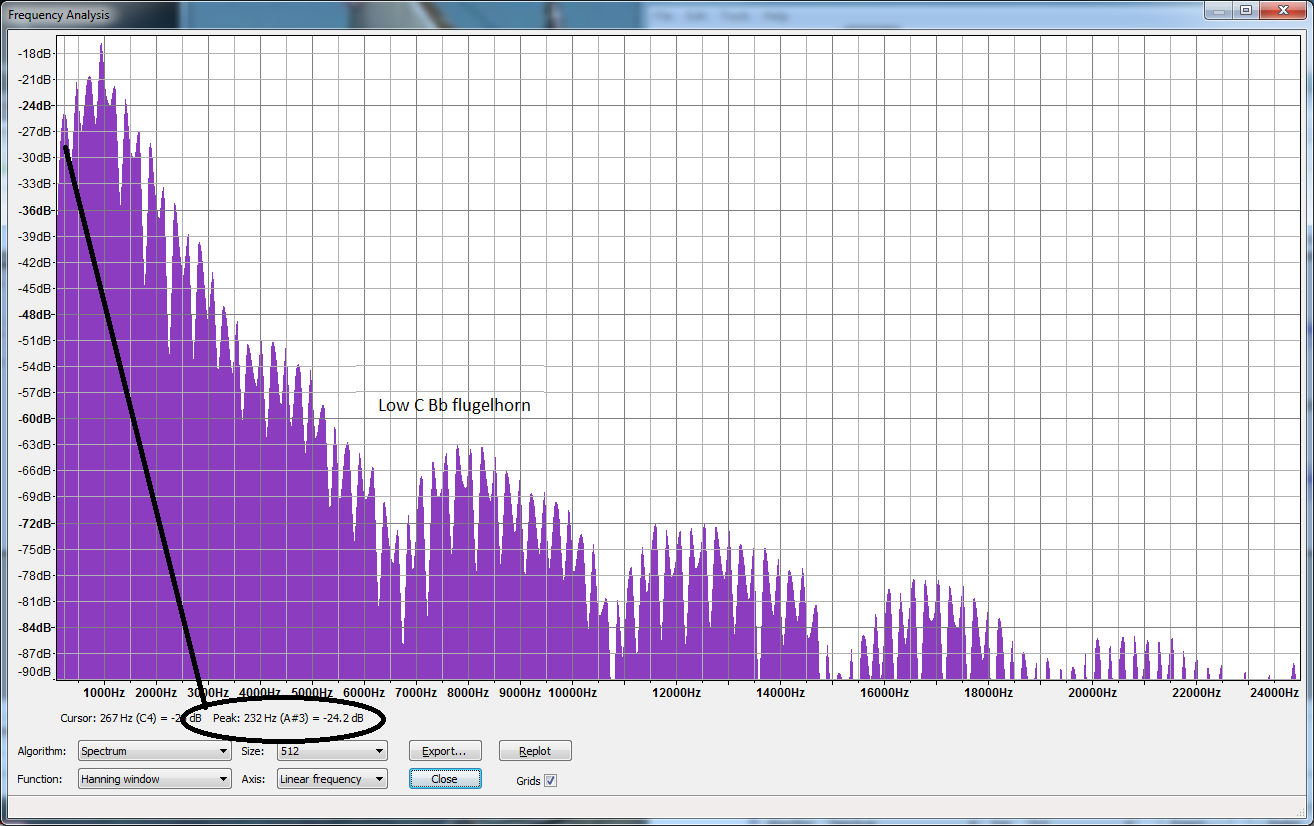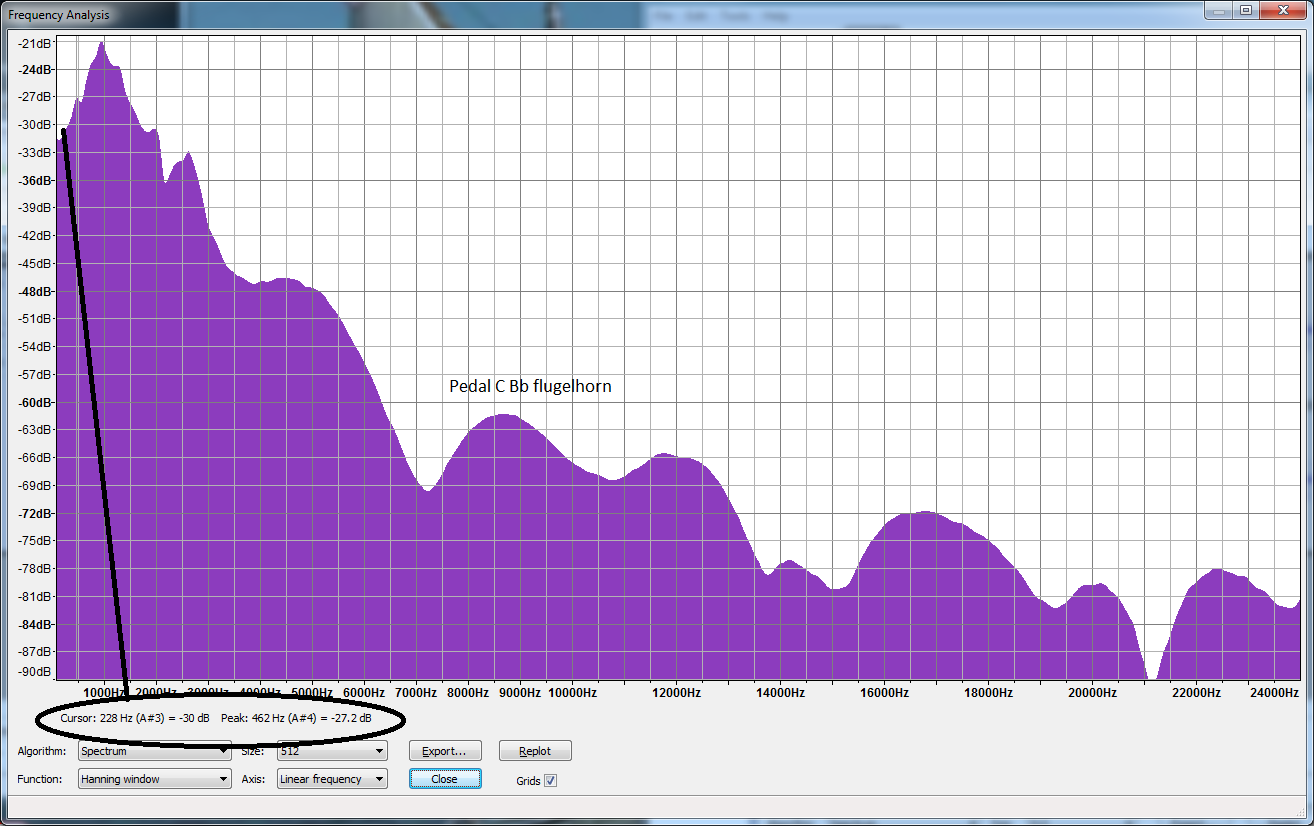Structure of the Trumpet by Yamaha
-
As a retired electronic engineer with radio communication experience I realized that the trumpet has similar characteristics as a radio frequency transmission line.
Regardless of buzzing or or just blowing air through a trumpet mouthpiece the resultant sound waveform as seen by an audio spectrum analyzer contains a whole mix of frequencies in the audible range. Applying this to the trumpet we have this mix traveling forward through the length at the speed of sound ~ 1200 ft/second. Some of this wave traveling forward will be reflected from the change in impedance of the tube in the region of the bell and will interfere with the forward traveling wave creating a new standing wave the frequency of which will depend on the length of tube and energy level of the reflected wave,
When a peak of the reflected wave reaches the lips coinciding with a trough in the forward wave the lips will close momentarily and then reopen by the air flow, according to Benade this takes around 3 cycles for the standing wave to stabilize.
An easy demonstration is to just blow air into the trumpet with the mouthpiece attached with relaxed lips and open aperture, while keeping the air flowing slowly close the aperture, a point will be reached when the standing wave will develop and the trumpet will sound.
References,
A Textbook of Sound Edwin H. Barton
Fundamentals of Musical Acoustics Arthur H. Benade
Music, Physics and Engineering Harry F Olson
Basic Physics Vol 3 Sound and Light Martin and Connor.
Regards, Stuart.
. -
@ROWUK not quite sure what you mean by "resonating at the whole wavelength" and "hear the overtone". When I play Bb3 or Bb2 (pedal) I hear the same pitch as a pure sine wave at those frequencies.
Speed of sound ~= 343 metres/second.
Length of Bb trumpet = 1.48 meters
Frequency = Speed of sound/wavelength 343/1.48 = 231 Hertz (Bb3 = 233.08 Hertz).
At “Low C” – A#/Bb3 the trumpet is one wavelength long.
Speed of sound ~= 343 metres/second.
Length of Bb trumpet ~= 1.48 meters
Frequency = Speed of sound/wavelength 343/1.48 = 231 Hertz -near enough to Bb3.I think I know where you are coming from Rowuk, with the reference to the actual spectra produced. I'd like to see spectra produced by some calibrated lab kit, but my Mickey Mouse setup (Zoom mike with iPhone, wave file fed into Audicity) shows the following...


I used a flugelhorn to produce the samples (FWIW) because pedal C slots a whole lot better and is more in tune than on a trumpet – you alluded to the small size of the bell at pedal C. The flugel also has a larger taper than a trumpet, I’m not making any assertions on this point but both the bell size and taper may change the playing of pedal notes. Important however is the that tubing length is the same. I’m guessing that the pedal C graph is muddier because the lower fundamental frequency means that harmonics will be closer together – and the spectrum analyser in Audicity is not great.
The chart for Bb3 indicates that 2nd, 3rd and 4th harmonics are stronger than the fundamental pitch, but the fundamental is certainly what we hear. -
@tjcombo
Is this sort of thing my cup of coffee? Nope, not even close. So I went to Physics Info./music to try and boil this into words I can understand and make sense of this. Correct me if I'm incorrect but the initial claim is that "we do not hear the fundamental frequency". If I'm wrong, make me suffer! Just take me out and make me eat Arby's Beer Cheese sandwiches with the pretzel bun. That would be good and fair punishment for misreading the claim. Yeah, that's the ticket! Here goes;
Like many other mechanical systems, musical instruments vibrate naturally at several related frequencies called harmonics. The lowest frequency of vibration, which is also usually the loudest, is called the fundamental. The higher frequency harmonics are called overtones. The human auditory system perceives the fundamental frequency of a musical note as the characteristic pitch of that note. The amplitudes of the overtones relative to the fundamental give the note its quality or timbre — pronounced in English as tæmbər or in quasi-French by English speakers as tɛ̃br with a nasal ɛ̃ for the medial e and silence for the final e. Timbre is one of the features of sound that enables us to distinguish a flute from a violin and a tuba from a timpani. So not only do we hear the fundamental, we also hear overtones relative to the fundamental, right? -
@Dr-Mark We are getting into the can of worms area. The terms "fundamental" and "harmonics" can quite correctly be used in the way you state. However, in trumpet land both these words can have a different specific meaning: the fundamental can be the pitch that is being sounded, and the harmonics can be the notes that can be played with identical fingering. I like to use the word "formants" to refer to the range of higher frequencies that determine the color of the note. Otherwise we are teasing our brains with "harmonics of harmonics".
One versed in the art of acoustics can freely discuss acoustics matters with their (or, previously his or her!) peers, but if such an expert discourses with a layman, misunderstandings and heat are inevitable.
My advice to all is to recognize that information is available, to recognize that this information does explain some of the intricacies of trumpet playing, then pick up our trumpets and play! At the end of the day A flat is still fingered 2 and 3.
-
Thanks Trumpetsplus
That does it, I've been jargonized. Off I go to Arby's to punish myself with Beer Cheese Sandwiches. -
As Rudolf Abel said in Bridge of Spies, Would that (the information) help?

-
@Trumpetsplus said in Structure of the Trumpet by Yamaha:
My advice to all is to recognize that information is available, to recognize that this information does explain some of the intricacies of trumpet playing, then pick up our trumpets and play! At the end of the day A flat is still fingered 2 and 3.
Yep
-
@Dr-Mark Although on 2 of my horns A flat is fingered 2 and 4!
-
This post is deleted! -
I finger this thread with a 2,

-
@Trumpetsplus said in Structure of the Trumpet by Yamaha:
One versed in the art of acoustics can freely discuss acoustics matters with their (or, previously his or her!) peers, but if such an expert discourses with a layman, misunderstandings and heat are inevitable.
That's a very good reason for those versed in the science/art of acoustics to speak in common terms. If they can only speak in their particular jargon, then they should seek a website that can help them render their message down so commoners not versed in the jargon can understand. Otherwise its just book smarts masturbation. Its best to know one's audience if a person wishes to be understood by more than a couple.
-
@Dr-Mark said in Structure of the Trumpet by Yamaha:
...for those versed in the science/art of acoustics to speak in common terms... only speak in their particular jargon, then they should seek a website that can help them render their message...
Not so sure the professional needs to seek a website to accomplish this. They merely just need listen and then hear their audience, and then, and only then can they render their message.
This concept I learned from teaching decades of medical students, but even more importantly, by teaching decades of my patients to ultimately strive to keep them in the best of health that is possible, not through my understanding of the disease process but through THEIR understanding of the disease process. No web site has taught me that... What has taught me to do that, is jazz improvisation.
-
Did any of you ever notice that a trumpet is twice longer than for instance a soprano saxophone that plays at the same pitch? If we analyse the spectra of the trumpet, we see the fundamental but primarily “hear” the first overtone. With the saxophone or flute, we “hear” primarily the fundamental.
-
@ROWUK said in Structure of the Trumpet by Yamaha:
Did any of you ever notice that a trumpet is twice longer than for instance a soprano saxophone that plays at the same pitch? If we analyse the spectra of the trumpet, we see the fundamental but primarily “hear” the first overtone. With the saxophone or flute, we “hear” primarily the fundamental.
Would this have anything to do with thr phase of the reflected wave, in a trunpet it closes the lips (reed) and in the saxophone it opens the reed, just a thought. Regards, Stuart.
-
@stumac Phase is not what causes the frequency that we "hear". I find more evidence that the size and taper of the trumpet bell "amplify" frequencies starting in the second octave. An 1300 Hz horn is around 4.8" in diameter at the mouth according to horn theory... This would damp the fundamental which is below cutoff severely.